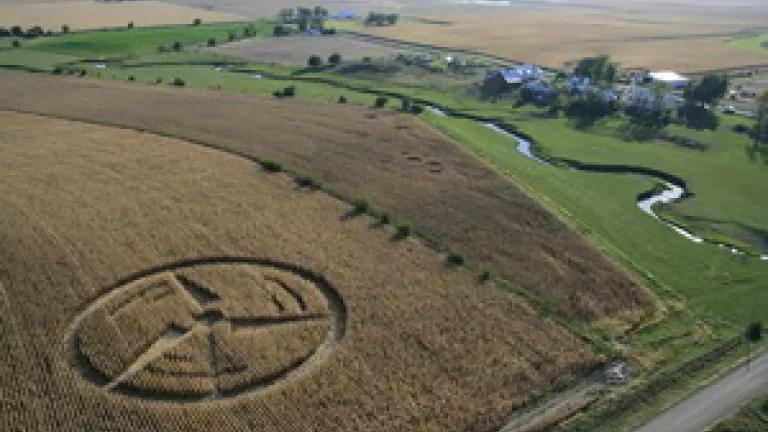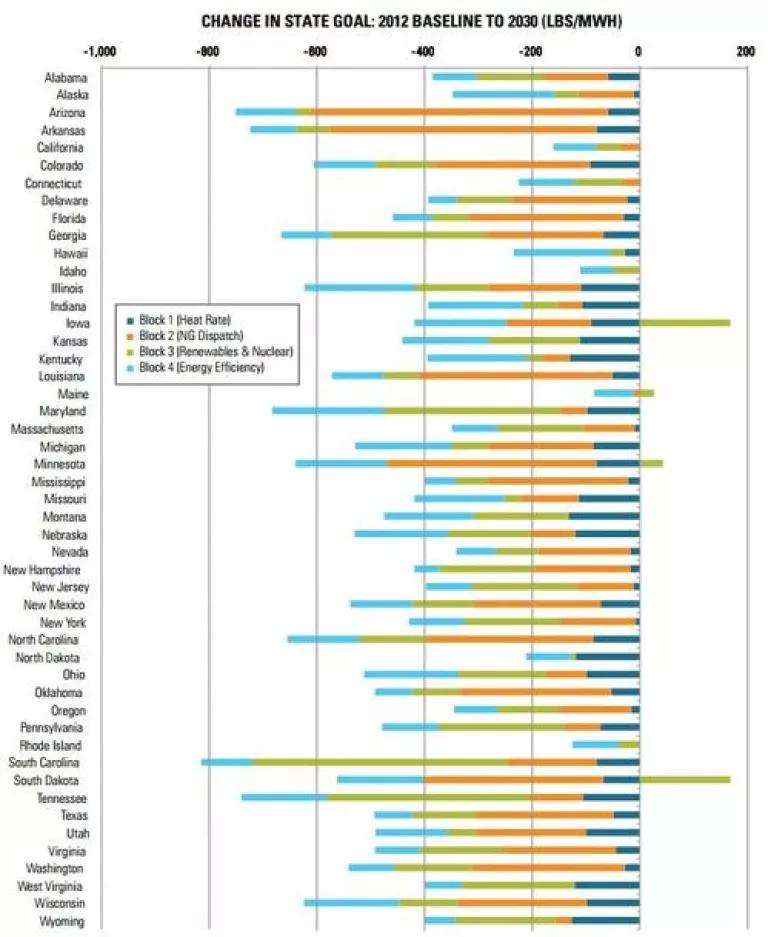
Iowa’s target under the U.S. Environmental Protection Agency’s (EPA) proposed Clean Power Plan would reduce carbon pollution by 16% by 2030. Iowa would reduce emissions from existing power plants from 1,552 to 1,301 lbs/MWh (the amount of carbon emitted per each unit of power produced). If EPA had simply used Iowa’s actual 2012 renewable energy generation, without even considering any growth in renewable generation over the decade, the state’s goal would have been 1,168 lbs/MWh, a 25% reduction. Instead, the agency undervalued Iowa’s existing renewables, giving the state a less stringent target because of its progress in clean energy.
Implicit Credit for Early Action
States have expressed concern about strong targets in those states that took early action to promote renewable energy and transition away from dirty generation. Iowa is one of those states, with wind at 820 installed Megawatts (MW) by 2005 and 5,005 MW by 2012. Today, Iowa has 5,177 installed MW that generate 27.4% of Iowa’s electricity, with another 1,055 MW under construction.
Although there is no explicit crediting built into EPA’s formula for calculating a state’s target, there is implicit credit. There are two factors that greatly influenced Iowa’s target: the formula for calculating each state’s renewable potential and the energy mix present in the state.
Calculating Renewable Potential
By averaging over a region’s existing Renewable Portfolio Standards (RPS) and their targets for 2020, EPA rewarded states that had performed beyond average and is asking for more from states that have made little progress, relative to other states in the same region, with similar available resources.
Iowa is located in the North Central Region. The five existing RPSs average out to 15.1% in 2020; EPA assumed that all states in the North Central Region could reach the average 2020 target by 2030.

By basing this part of the target calculation on existing state policy, EPA thereby trusted those states’ judgment of their own potential for reasonable, cost-effective, technically possible renewable energy generation growth over time.
Iowa has already surpassed the North Central regional 15% renewable energy target, with 14,183,424 Megawatt-hours (MWh) or 25% of total generation from renewables in 2012. In calculating the state’s target, EPA did not assume any additional renewable energy for Iowa in future years. Instead, the agency underestimated Iowa’s current and future potential, assuming a low 8,565,921 MWh of renewables throughout the implementation period, which was already surpassed by 2010. Because the incredible progress made in Iowa was undervalued in the target-setting process, EPA assumes that lesser savings are possible with renewables than is actually the case. This results in a less stringent target for the state — the state receives credit for its early action on carbon reduction.
In fact, if EPA had used Iowa’s actual 2012 renewable energy generation, without even assuming any growth in renewable generation over the decade of implementation, the state would have been given a target of 1,168 lbs/MWh rather than 1,341 lbs/MWh. This number is calculated by simply adjusting the number for renewable generation in EPA’s formula for calculating state targets, explained here.
When looking at regional deployment of renewables, Iowa certainly stands out, surpassing the regional average goal for 2020 already by over 13%. As seen in the bars that extend past the axis in Figure 1 below, Iowa is one of a few states that received implicit credit for its early renewables development. With this credit, Iowa has more flexibility in complying with the Clean Power Plan. While EPA assumed when setting the target that no additional renewables will be added in Iowa and that reductions would come from energy efficiency, natural gas, and more efficient coal, the state could still further deploy renewables and thereby rely less on polluting natural gas and coal.
All in all, Iowa was given a great deal of credit for its early action on renewables. By comparing Iowa to its neighboring states in the target-setting process, the agency undervalued Iowa’s existing renewables. As a result the state has the fifth-lowest target in the nation and a great deal of flexibility in compliance.
Figure 1: Contribution of Each Building Block to the State Goal

A Balanced Energy Mix
Most of the differences between states’ targets under the proposed rule are based not just on the progress a state has already made but also on the existing energy mix – specifically, the balance between coal and natural gas. States that are greatly dependent on any one source of electricity will have less stringent targets, because EPA assumes that it will be more costly to transition away from those fuels.
For instance, Texas has a more stringent target than does Kentucky because Texas has existing natural gas plants that could be run more and offset the more polluting coal plants. In contrast, Kentucky would have to build new natural gas plants in order to shift generation in the same way. This results in a lot of carbon reduction potential in states that already have many natural gas power plants but little reduction in states with few or no gas plants.
So, although Iowa’s target seems tougher than that of Kentucky and North Dakota, that actually reflects the fact that it will be less costly for Iowa to run existing natural gas plants more than it will be for Kentucky and North Dakota to build new units. And, because natural gas still makes up a relatively small portion of electricity generation, EPA assumed little carbon reduction from ramping up natural gas (compare Iowa to Arkansas in Figure 1, above).
In summary, Iowa is in an excellent position to comply with EPA’s Clean Power Plan as it is currently proposed. EPA gave the state so much credit for being an outlier in the North Central Region that Iowa will likely far surpass its targets by 2030. It is possible to achieve even greater reductions in carbon pollution, even from those states that have already made tremendous progress. Instead of simply getting credit for past action, Iowa should look ahead and lead the rest of the nation in confronting a global problem, showing what change is possible.
Image: Turbine crop formation in Iowa field, by B.G. Johnson, licensed under Creative Commons
